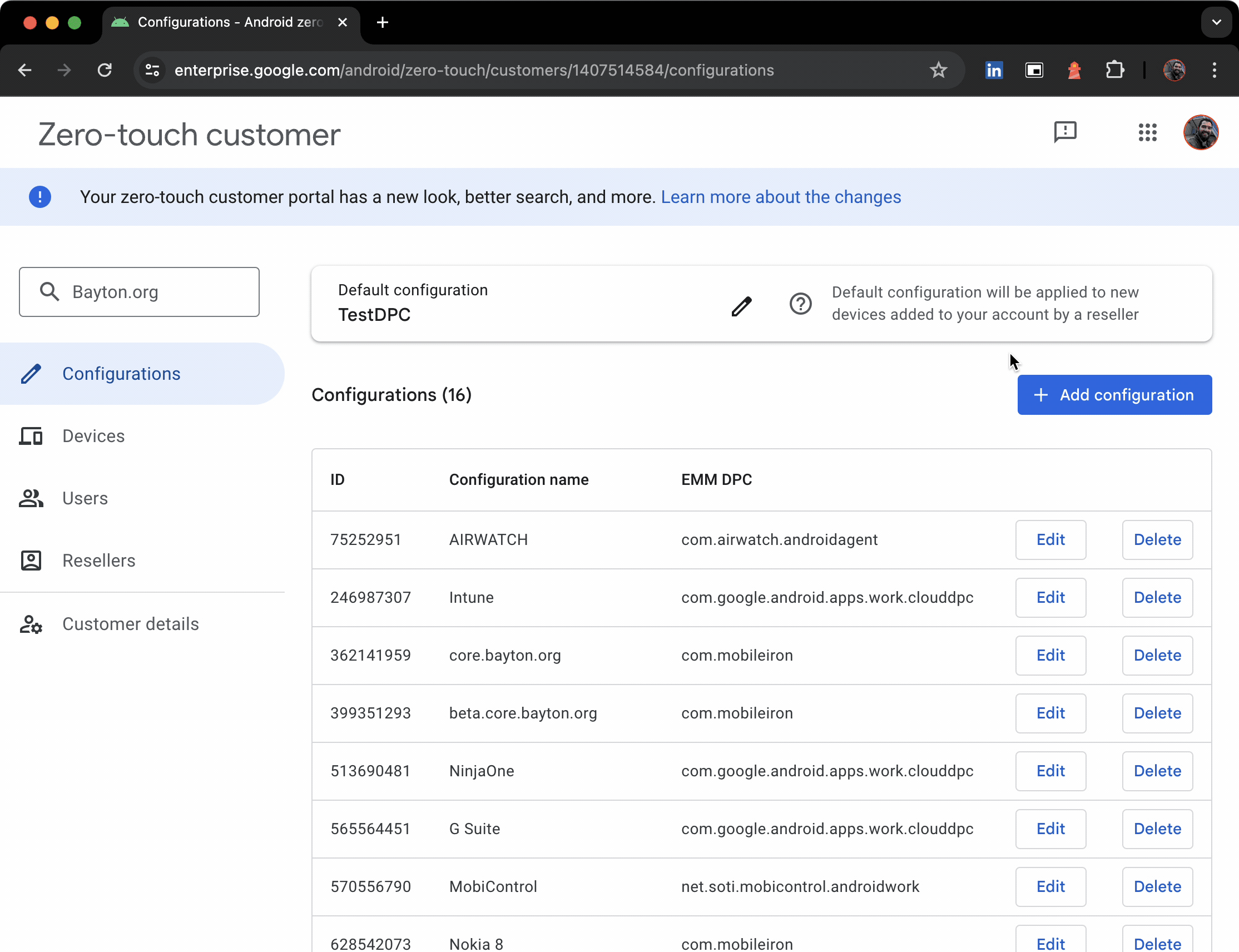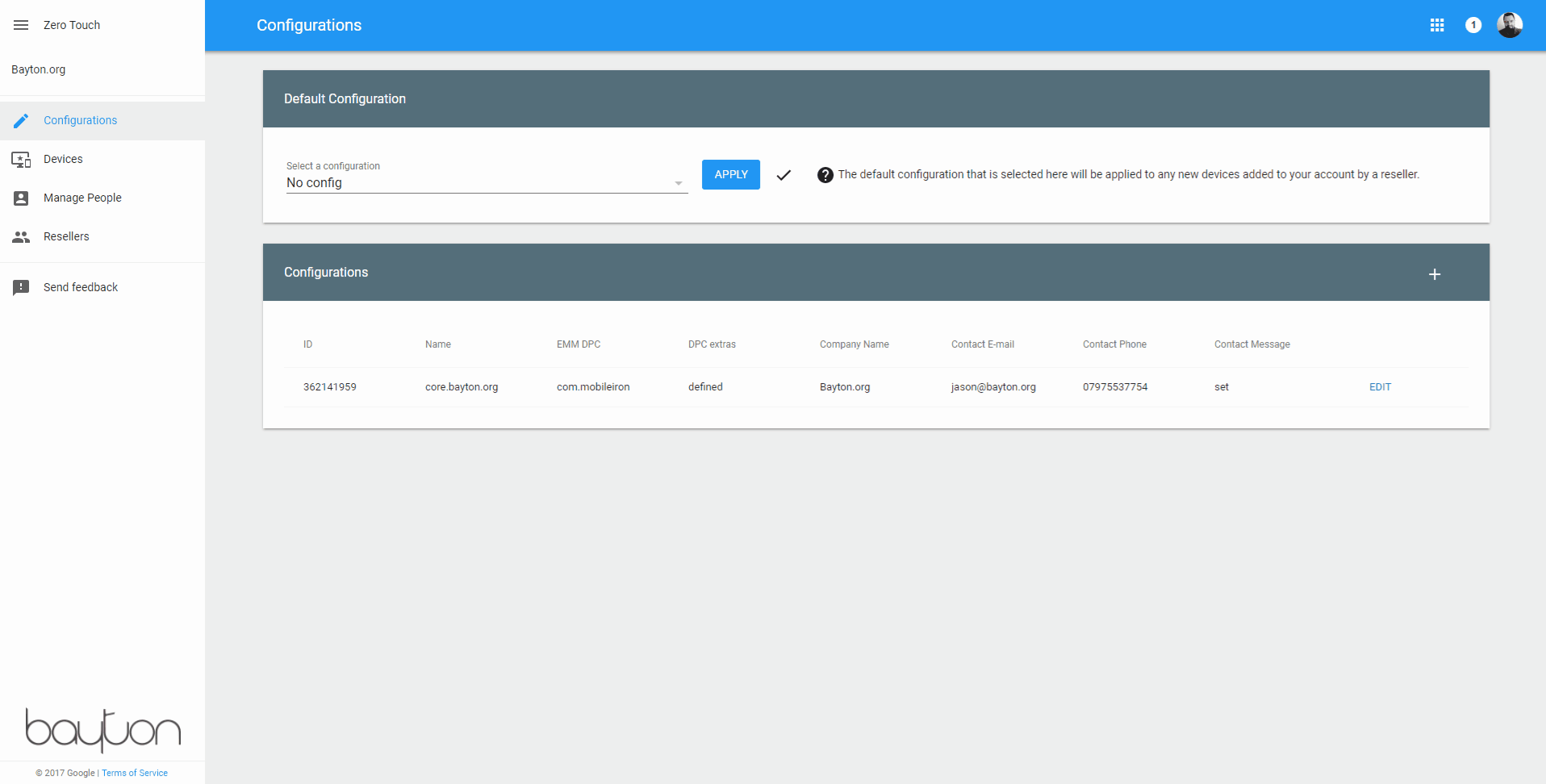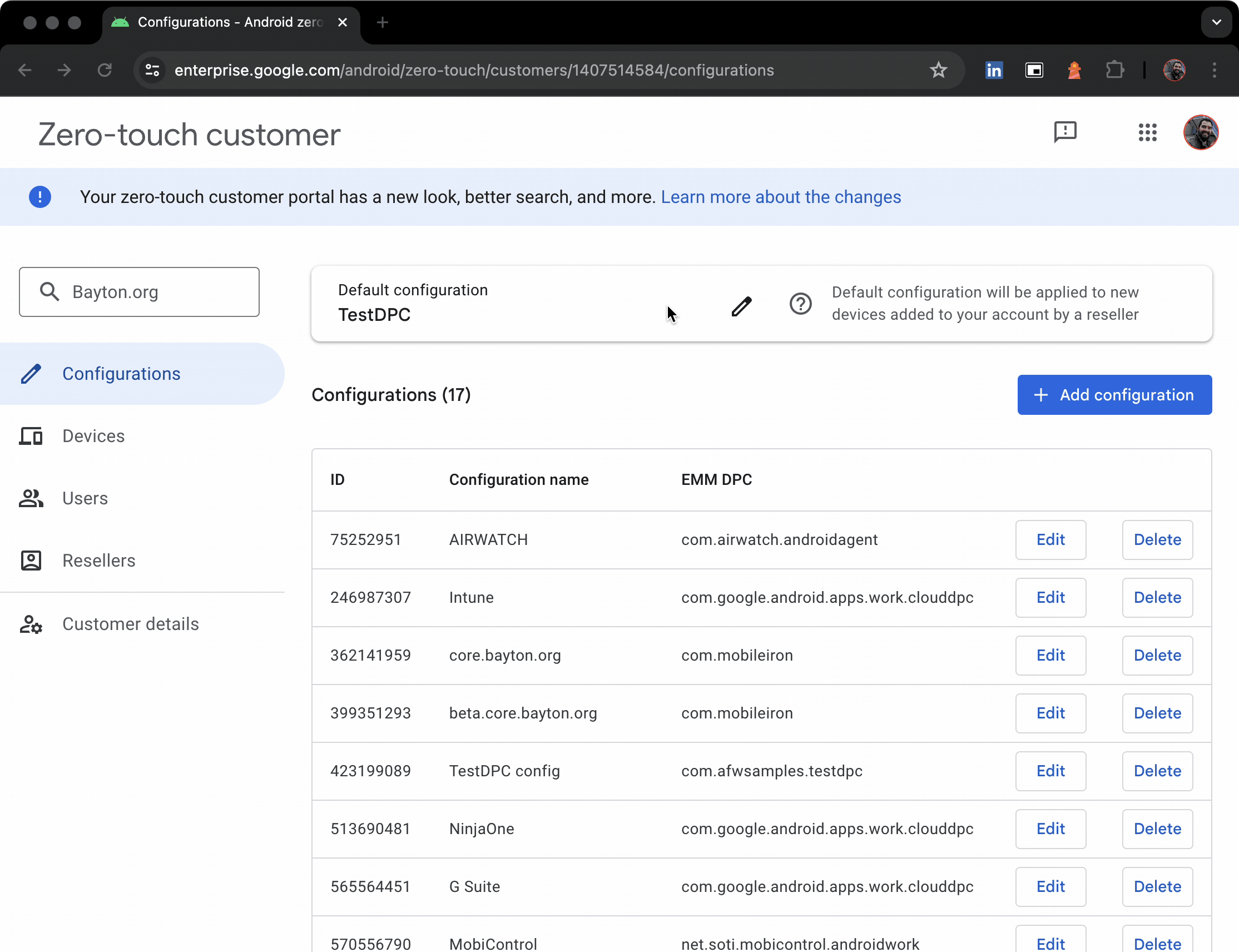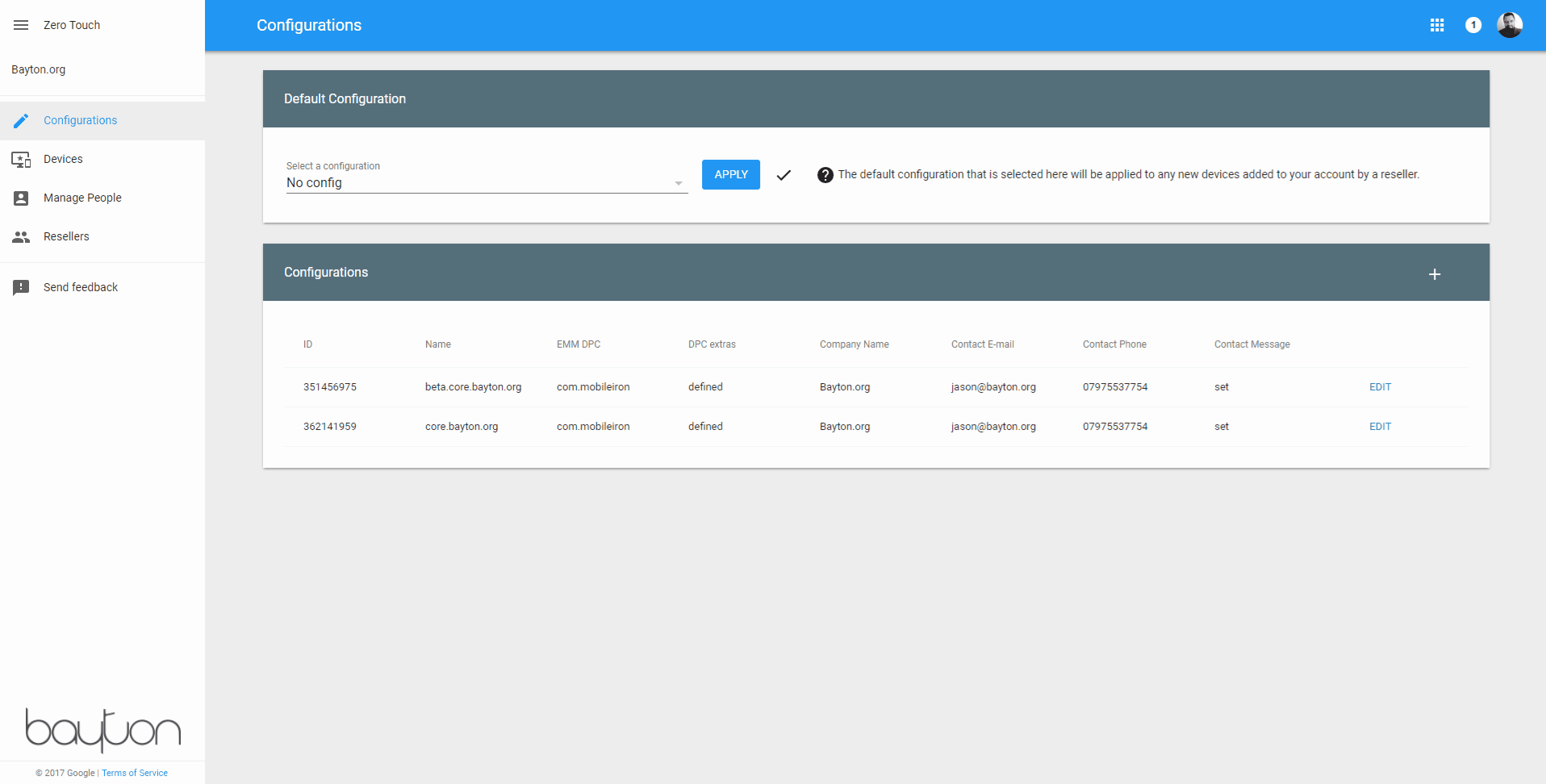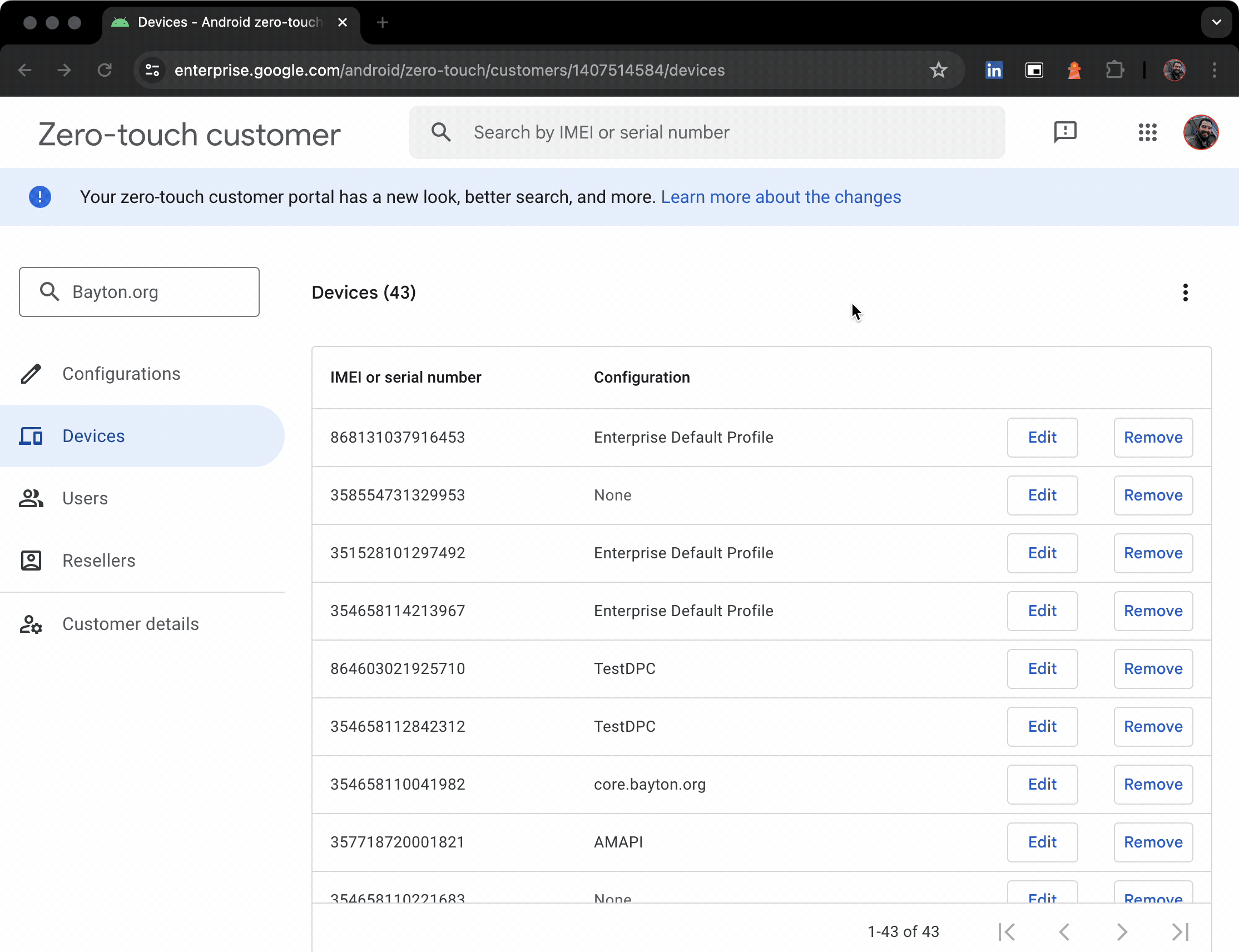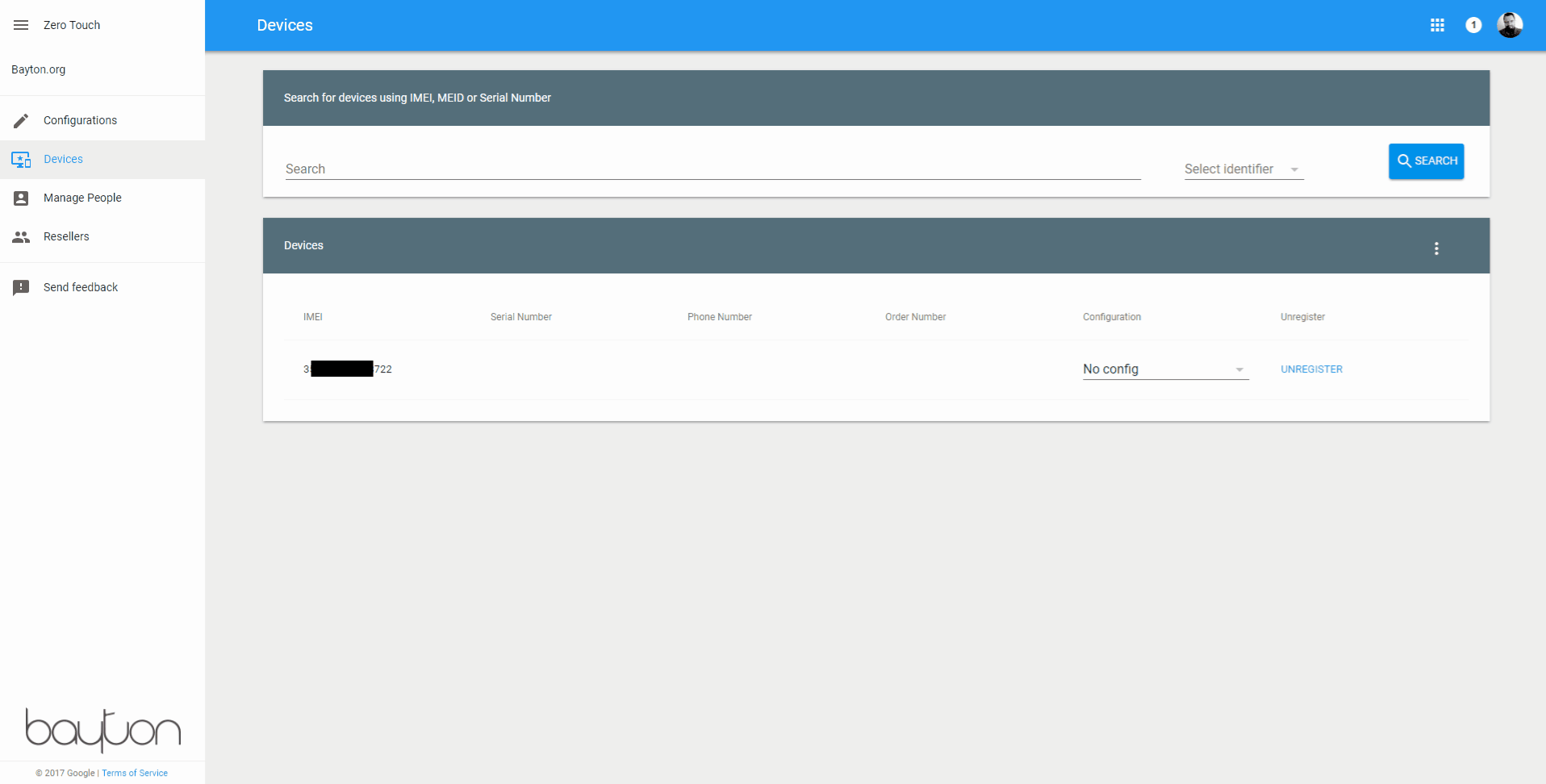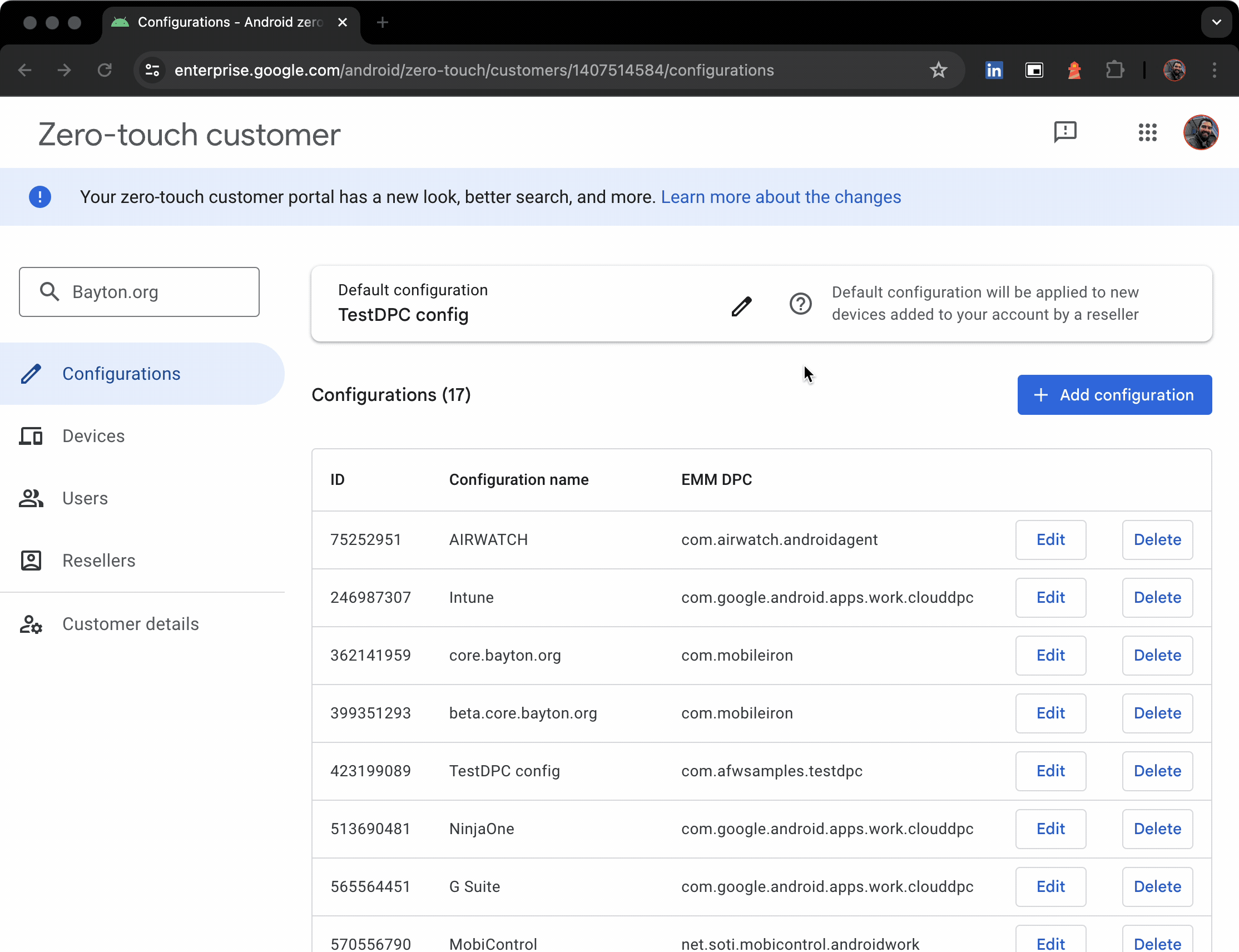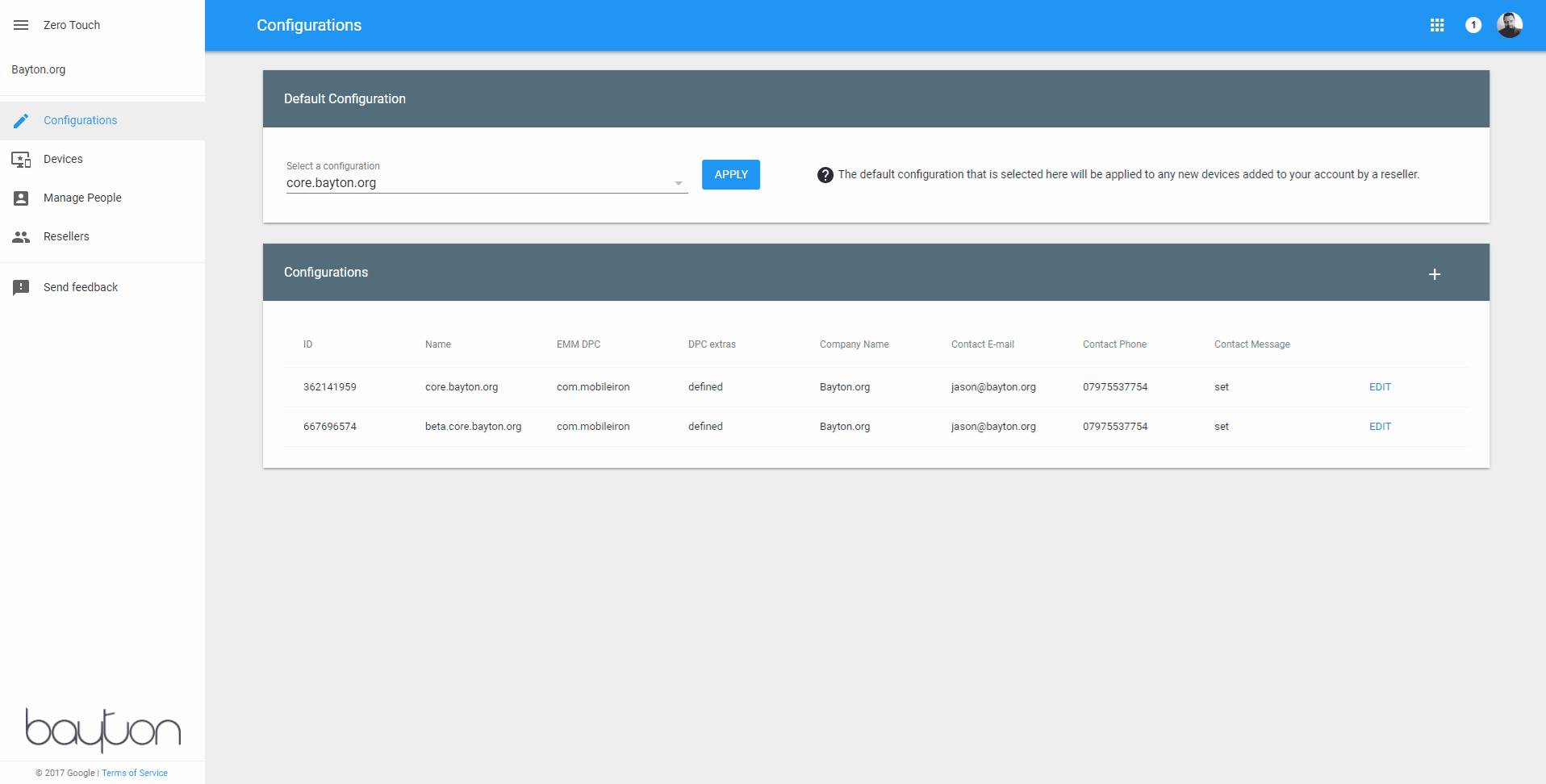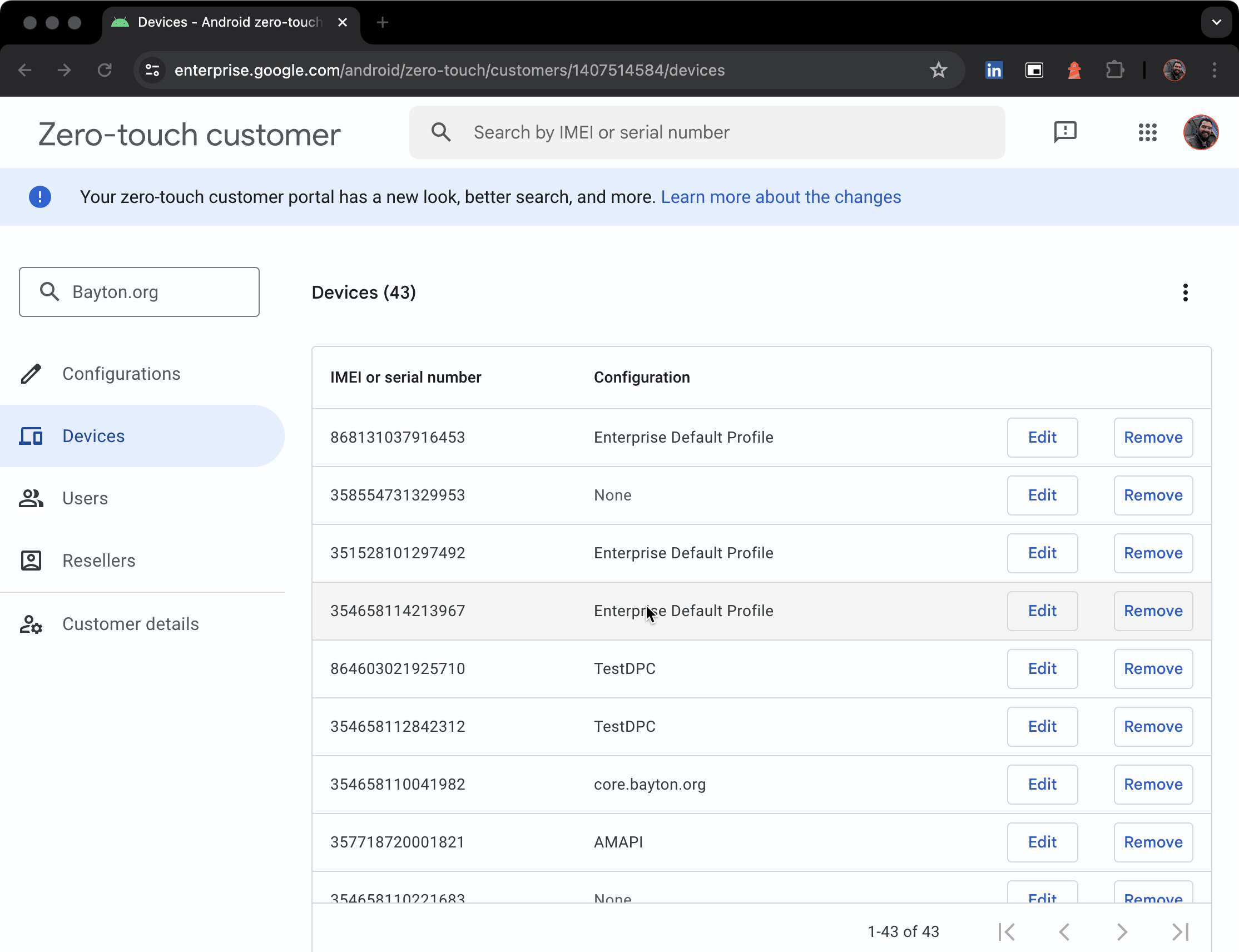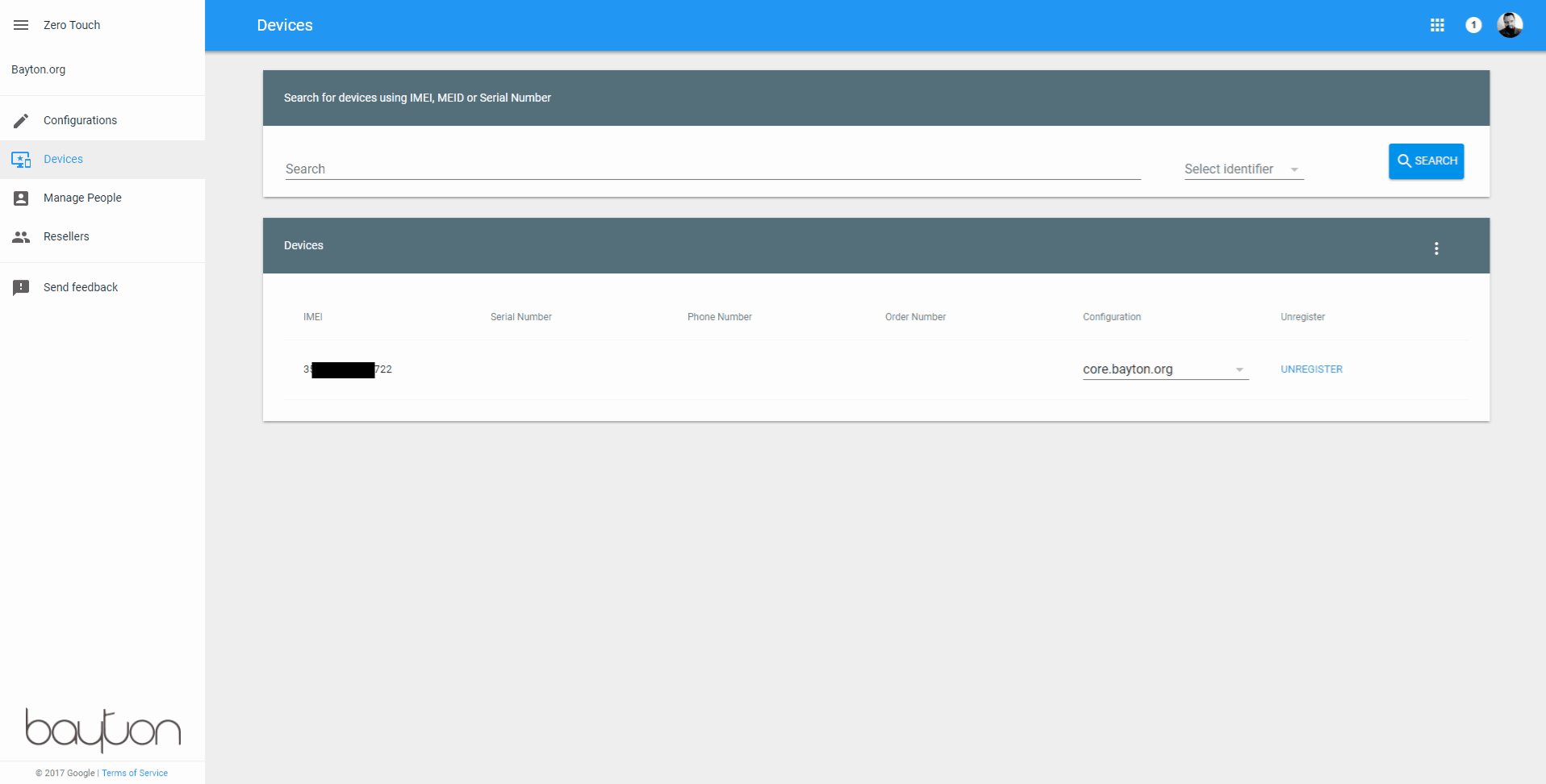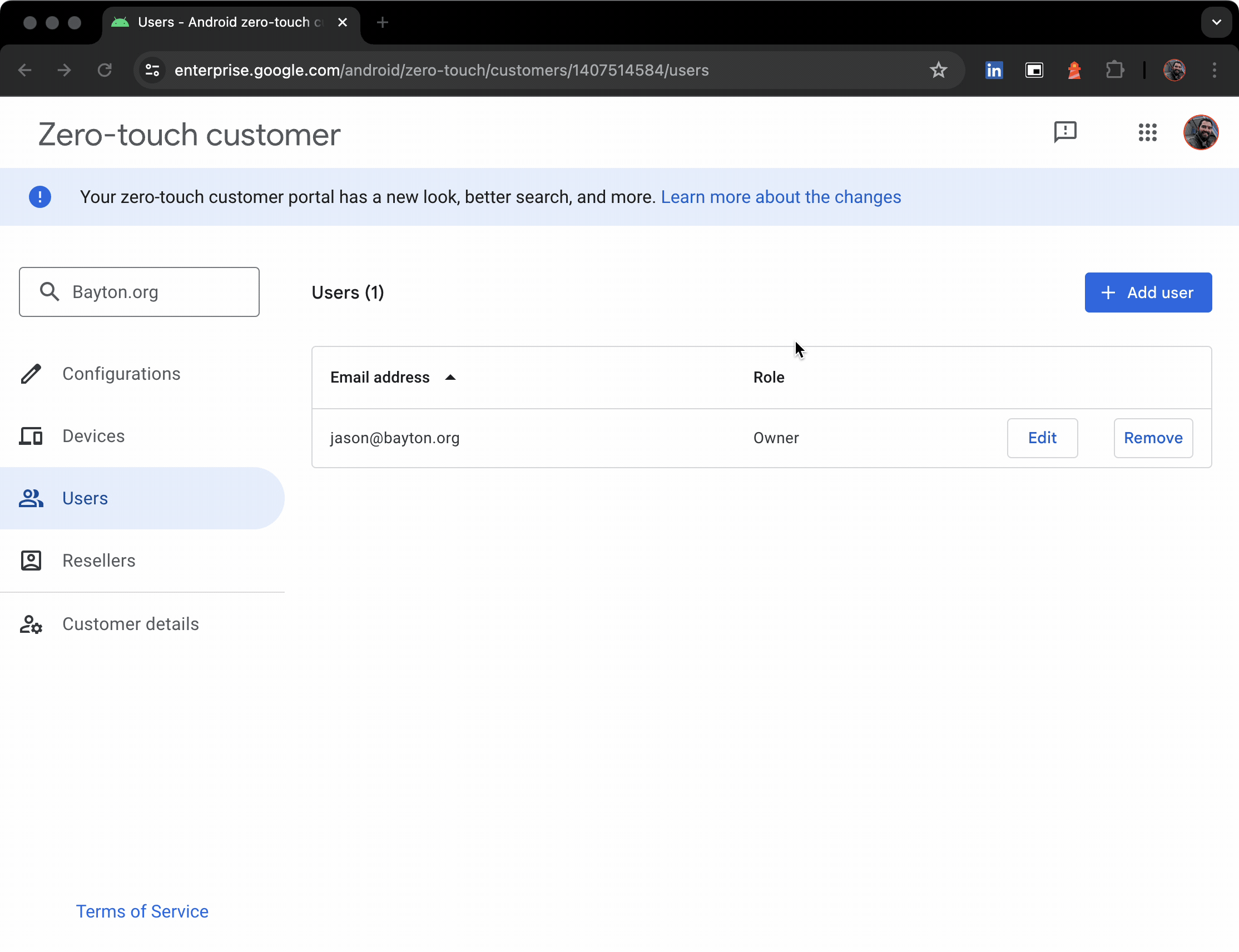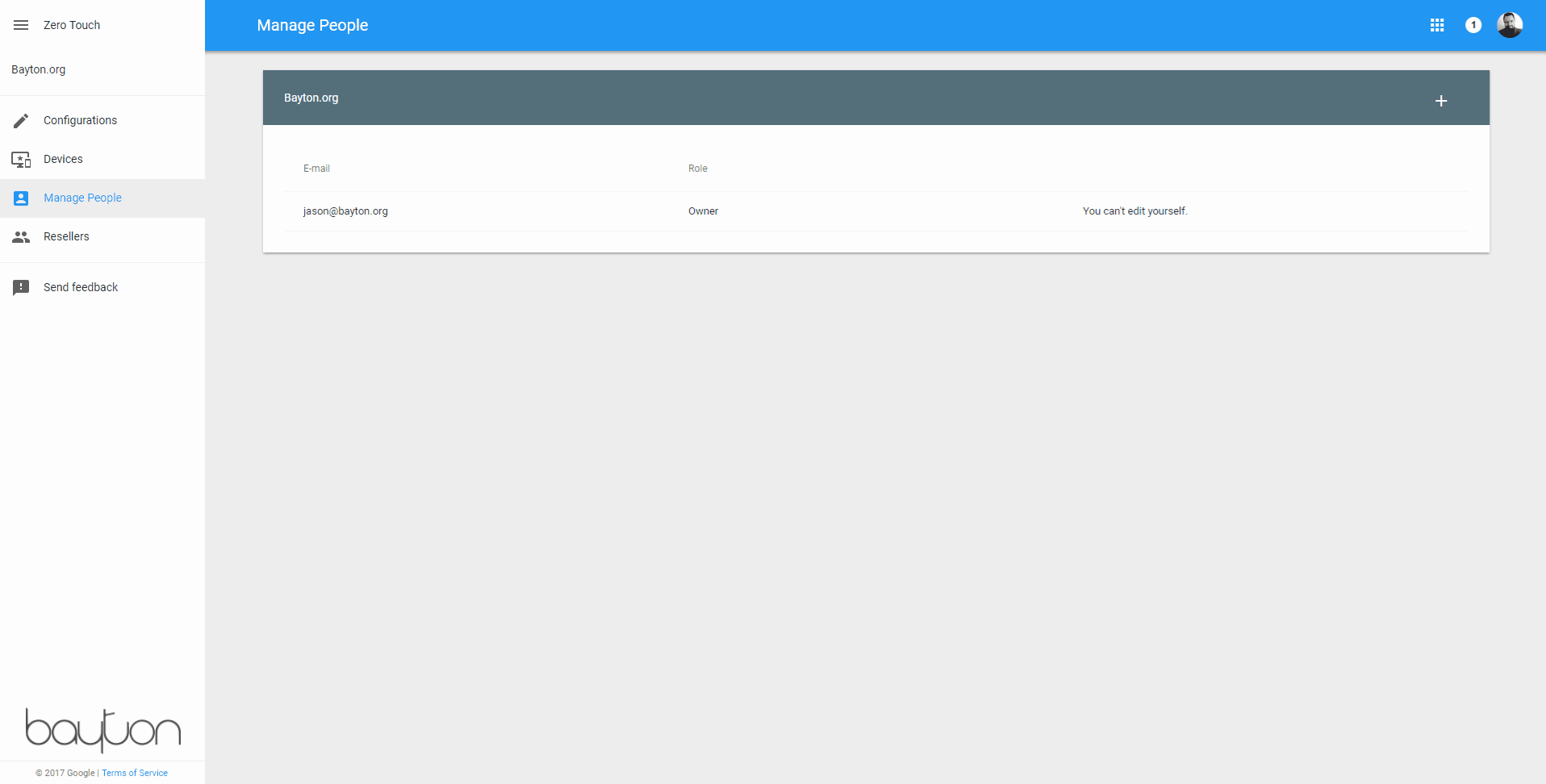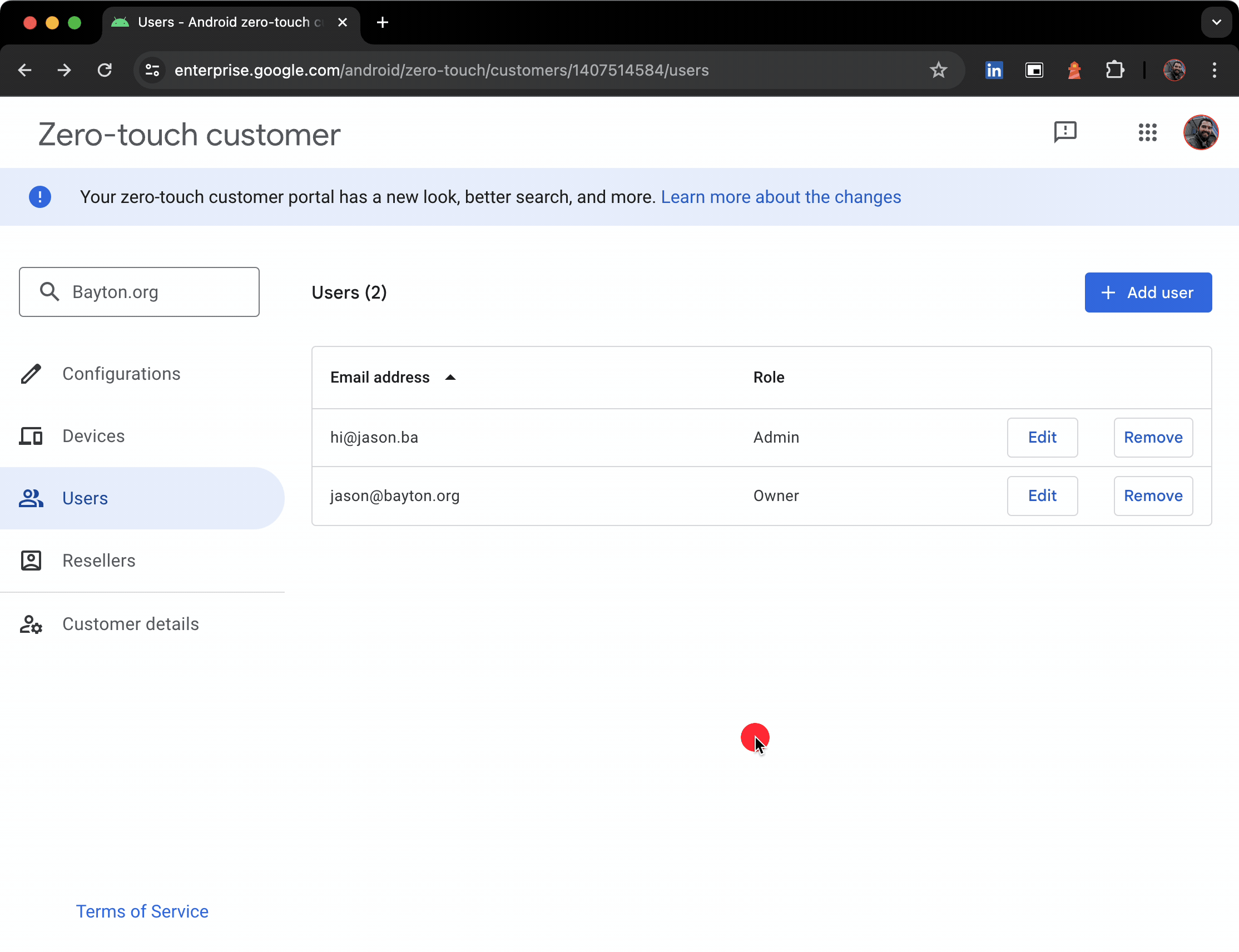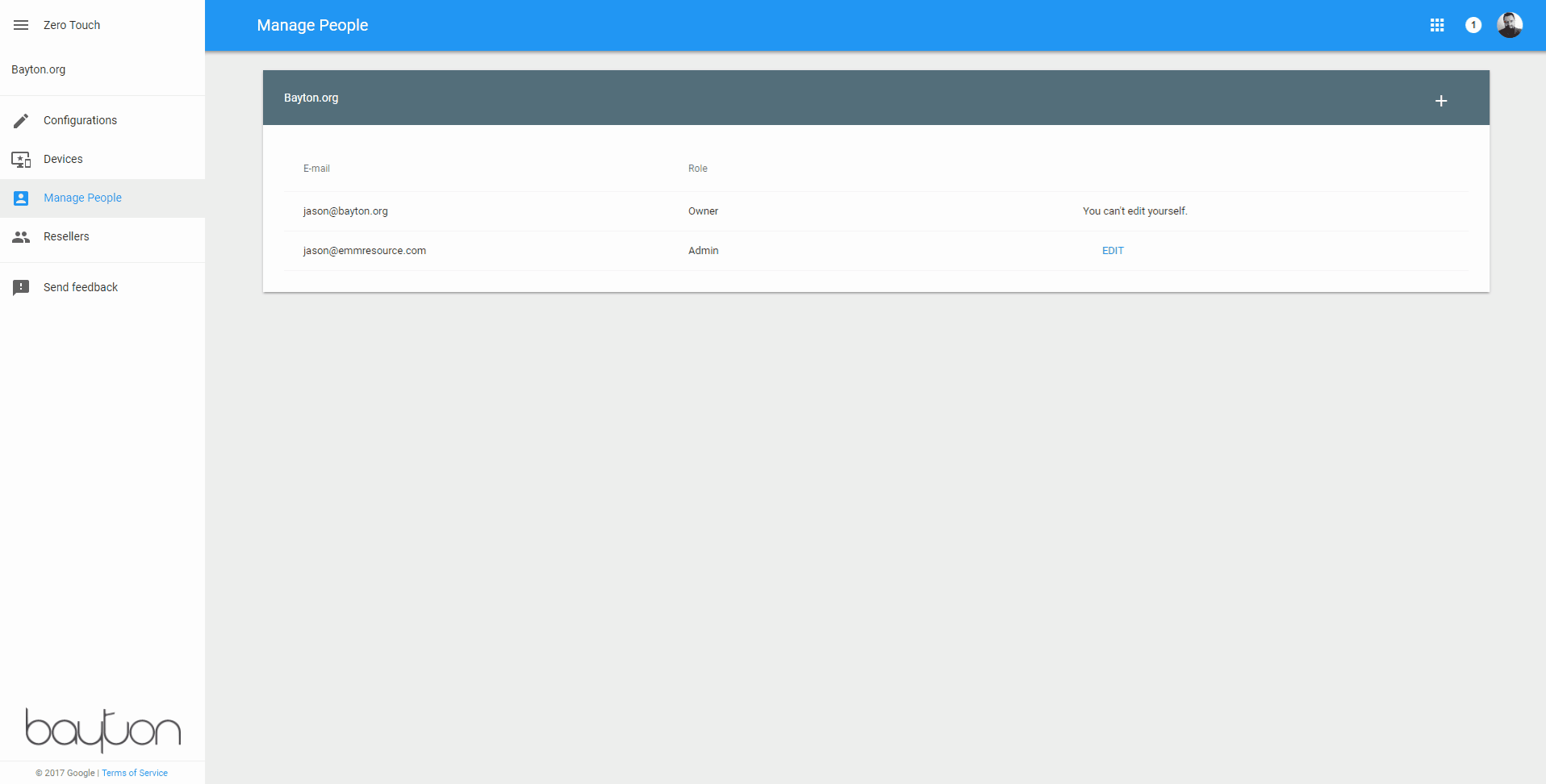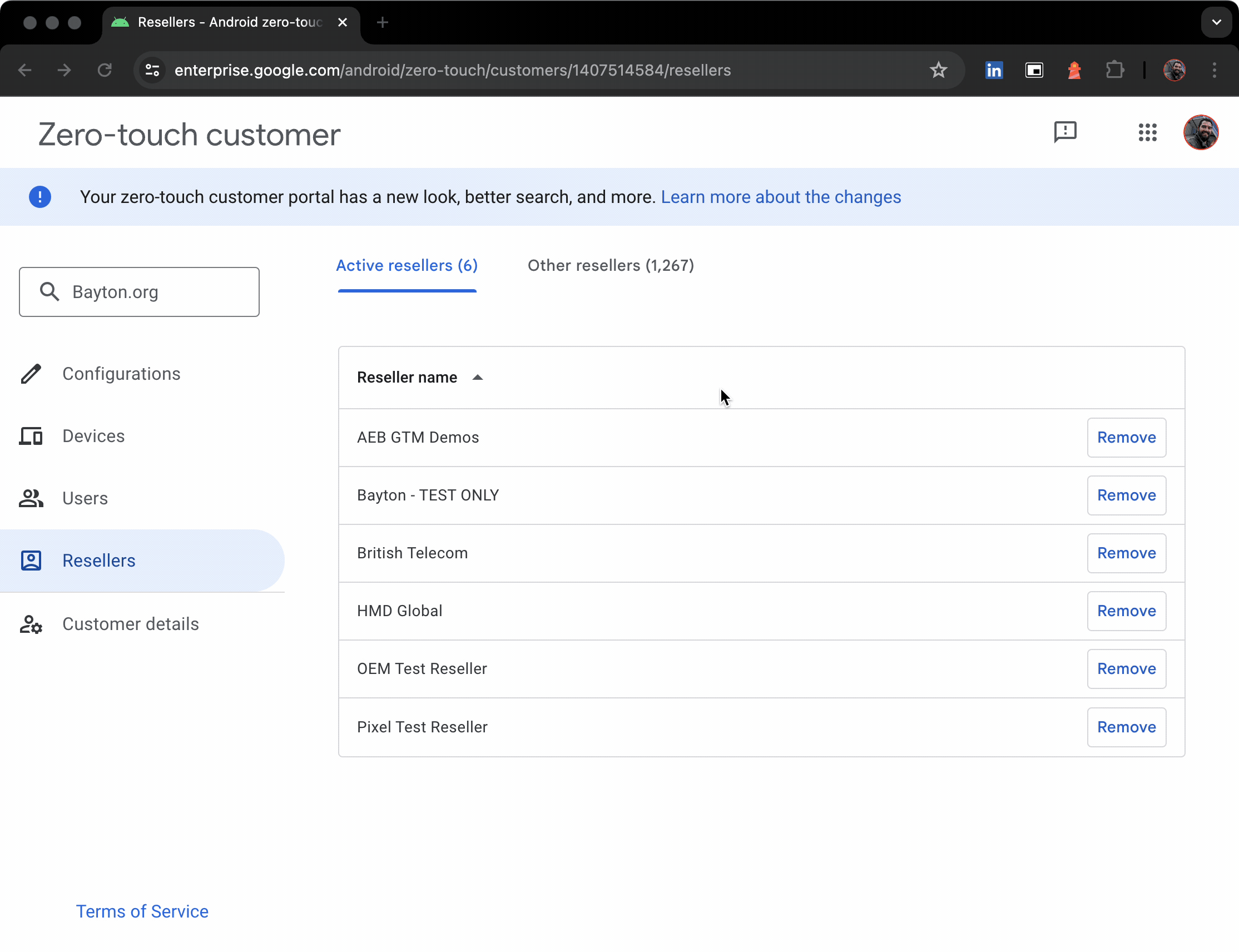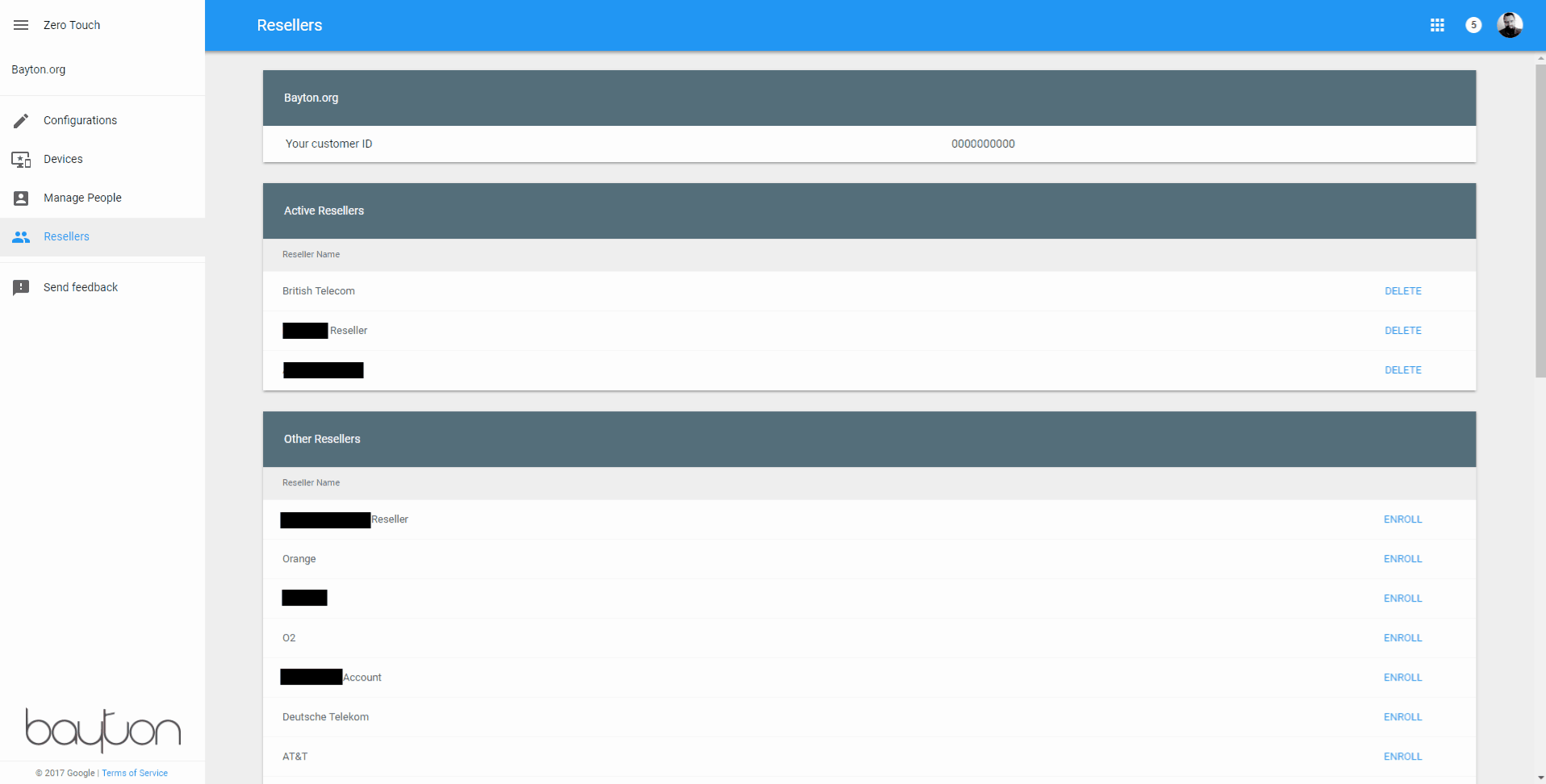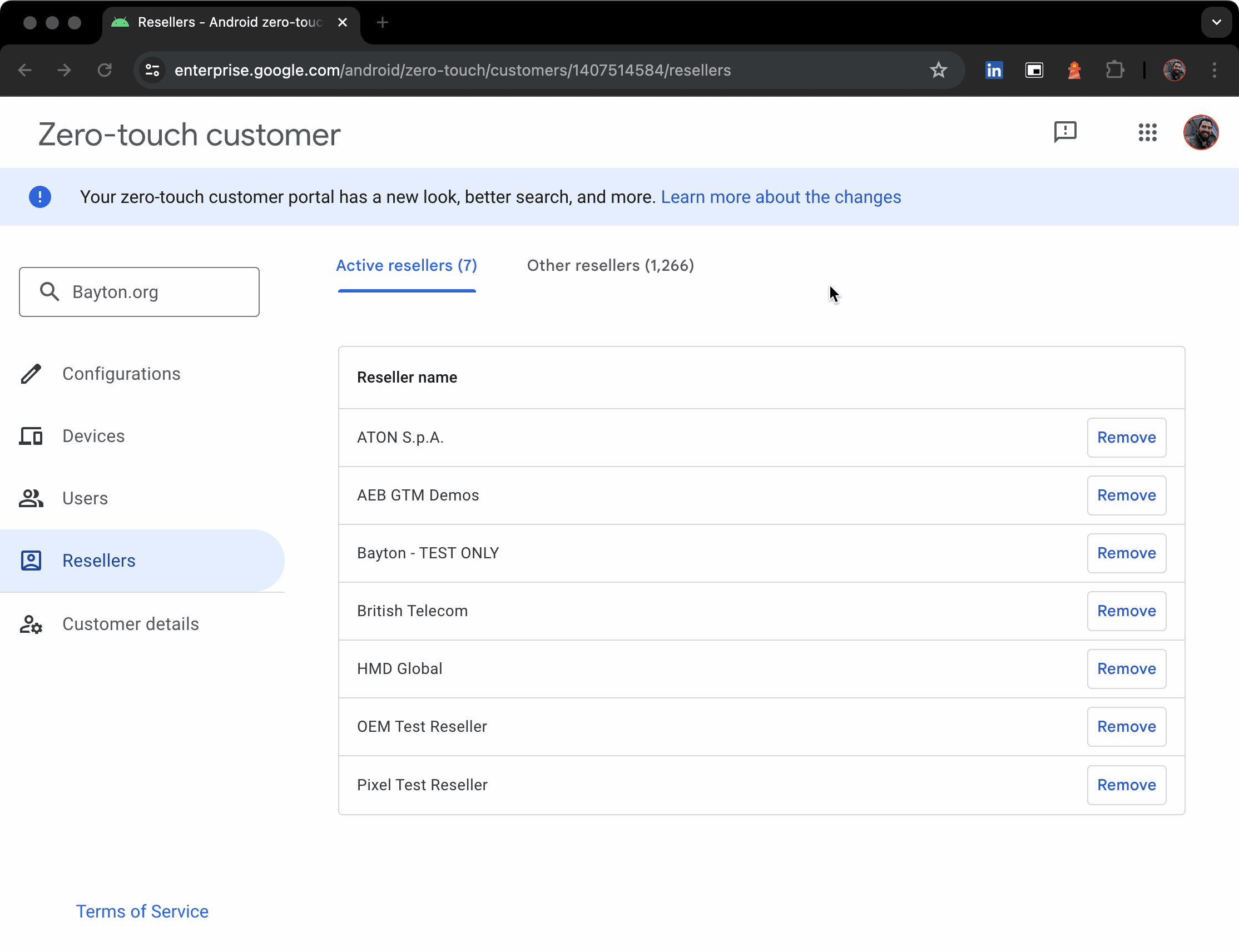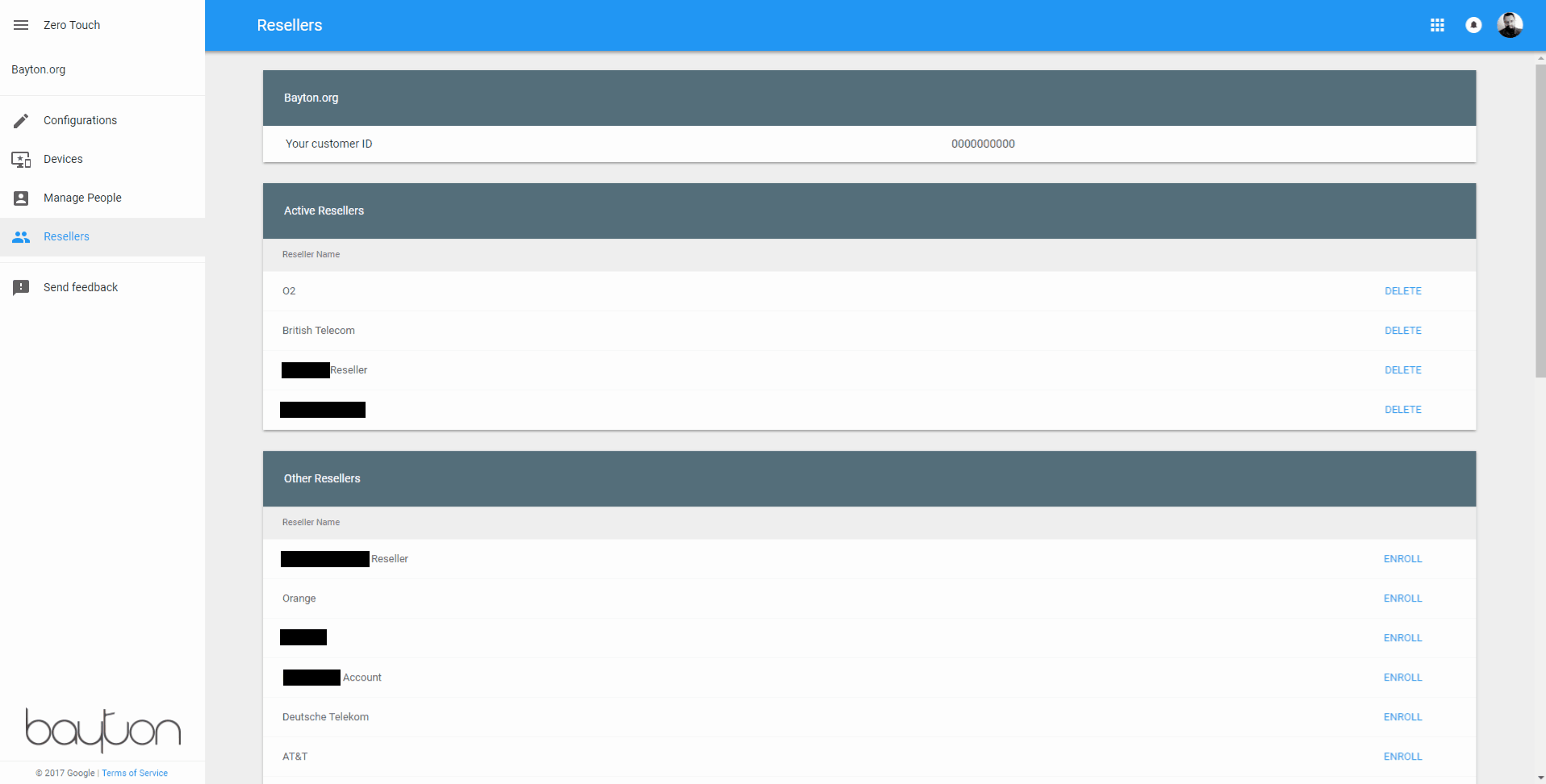Contents
Docs
General
- Introduction
- What is Android Enterprise?
- Android versions matrix
- Considerations when migrating from device administrator to Android Enterprise
- Android Enterprise feature requests
- What is Android Enterprise Recommended?
- Android Enterprise FAQ
- Android Enterprise device testing
- What is Private Space in Android 15, and how can organisations manage it?
- Why don't all Android devices come with GMS?
- What is Android One?
- Android Enterprise vs Device Admin: Why DA is no longer suitable
- Considerations for choosing Android in the Enterprise
- Feature spotlight: Android Smartlock
- Android glossary
- Android version evolution graphics
- Infobyte: Device Admin deprecation
- How to submit a device for Android Enterprise Recommended validation
- How to capture a bug report and device logs
- How to view software version information
- Gartner comparison of security controls for mobile devices 2019
Provisioning
- How to become a zero-touch enrolment reseller
- What is Android zero-touch enrolment?
- Android Enterprise zero-touch console administration guide
- Android Enterprise DPC identifier collection
- Android Enterprise provisioning guides
- Android Enterprise zero-touch DPC extras collection
- Infobyte: Android Enterprise deployment scenarios
- Infobyte: Android Enterprise fully managed provisioning methods
- Manual Android Enterprise work-managed QR code generation for MobileIron
Work profile
Fully managed
App management
- Set up Hypergate's Kerberos Authentication on MobileIron Core for Android Enterprise
- Managed Google Play, allowlist or blocklist?
- Considerations when deploying MTD with Android Enterprise
- Why you shouldn't install apps from unknown sources
- Create and manage private apps for Android Enterprise
- What is OEMConfig?
- Create and manage web apps for Android Enterprise
- How to locate a private Android app assigned to an organisation ID
- How to host enterprise apps outside of Google Play
- The Google Play iFrame app approval flow is deprecated
- Android 13 adds notifications access as a runtime permission
- Android 14 blocks apps targeting old Android versions
- Android 13 & up restricts permissions when apps are sideloaded
- Android system apps database
- How to resolve common Android app install failures, by error message
FAQ
- Is Android Enterprise supported on uncertified (non-GMS) devices?
- Can apps be sideloaded into the Private Space?
- Is Private Space supported on fully managed devices?
- Why don't Private Space apps go through VPN?
- Is it possible to manage personal applications on a work profile device?
- Does Samsung support Android Enterprise?
- How can apps be managed in the Private Space?
- Are Private Space apps visible to enterprise admins?
- Are Private Space applications truly hidden?
- Why has USB data access been disabled suddenly?
- What versions of Android support Android Enterprise?
- Is it possible to manage eSIM?
- How to check if an Android device is GMS/Play Protect certified?
- To use Android Enterprise do I need to buy Google Workspace (G Suite) and register my domain?
- What devices should I buy for my organisation?
- If Android Enterprise is supported from Lollipop, why is Marshmallow often mentioned instead?
- What’s the difference between Device Admin and Android Enterprise?
- What is the Android Enterprise bind?
- Can I change the account I used to bind Android Enterprise?
- Is it possible to bind Android Enterprise with multiple EMMs using one account?
- How do I remove the Android Enterprise bind from my current EMM?
- What is Android Enterprise Recommended?
- My AER device doesn’t work properly with Android Enterprise, what should I do?
- Is Android One better than AER? (Or the other way around?)
- How do I configure Google Workspace domains for provisioning?
- What’s the best provisioning method?
- What’s the difference between allow adding accounts vs allow configure credentials?
- Is it possible to utilise multiple VPN connections within a profile?
- Is it possible to utilise a single VPN connection across the entire device?
- Does Android support Kerberos natively?
- What’s the difference between device based accounts and user based accounts?
- How do I manage the new notifications runtime permission in Android 13?
- Can organisations see applications outside of the work profile?
- Can organisations deploy applications to the parent profile in a work profile deployment?
- Is it possible to migrate from DA to AE work profile without a re-enrol?
- What is a work challenge?
- Enrolment failed but the work profile was created. How do I remove it?
- How can I provision a fully managed device?
- Is it possible to “retire” (or enterprise wipe) a fully managed device?
- Devices factory reset as soon as they’re enrolled, why?
- Is Factory Reset Protection enabled on fully managed devices?
- Is it possible to migrate fully managed devices between EMM solutions?
- How has COPE changed in Android 11?
- Does Intune support COPE?
- Can organisations see applications outside of the work profile on a COPE device?
- Can organisations deploy applications to the parent profile in a COPE deployment?
- Is it possible to migrate from fully managed to work profiles on fully managed devices?
- How should system applications be handled on a COPE device?
- What OEMs currently support zero-touch?
- Where are zero-touch resellers located?
- Does zero-touch cost anything?
- Is an EMM still required with zero-touch?
- What happens if a fully set up device is added to the zero-touch console?
- What happens if a user starts setting up a device before the zero-touch config is applied?
- What happens if a zero-touch config is removed from an enrolled device?
- What happens if a new config for a different EMM or server is applied to an enrolled device?
- Can I add/remove users on a fully managed device?
- How can I access a Wi-Fi captive portal when devices are in Kiosk?
- What happens if a zero-touch assigned device is reset?
- What happens if a device is unregistered from the zero-touch console?
- Can a device be OTA managed from the zero-touch console?
- Does enrolling via zero-touch slow down or cause any delay to the setup process while it’s retrieving the zero-touch config?
- What deployment scenario will a zero-touch device enrol under?
- Why does zero-touch require so much touching?
- Can anyone add a device to the zero-touch console?
- Is it possible for an organisation to add previously-purchased devices to zero-touch?
- Can a MADA device be converted to EDLA?
- Can anyone remove a device from the zero-touch console?
- Does Samsung support zero-touch?
- Is it possible to set a zero-touch default configuration?
- Is it possible to bulk update zero-touch devices?
- Is it possible to change zero-touch resellers?
- Are all zero-touch devices Android Enterprise Recommended?
- What are DPC extras?
- What should I put in DPC extras?
- What happens if a device is uploaded to zero-touch with the wrong manufacturer?
- The device registered with zero-touch, but doesn’t launch during setup, why?
- Does Android Go support zero-touch?
- Are employee-owned devices eligible for zero-touch?
- What’s the recommended way of managing private (in-house) applications?
- How do I turn off Google Play app collections?
- Is it possible to deploy app shortcuts to the homescreen of an Android Enterprise device?
- Is it possible to backup & restore device data on a fully managed device?
- The Google Play iFrame is missing a feature in my UEM. How do I enable it?
- How do I configure allowlist/blocklist domains for Google Chrome?
- How to configure Chrome managed bookmarks
Change log
Android Enterprise zero-touch console administration guide
Contents
Zero-touch enrolment has been covered in depth in What is Android zero-touch enrolment? This document offers a good overview of what it is and why zero-touch is the future of Android management.
There are two scenarios for which the zero-touch console is used, as an organisation or as a reseller. This guide targets the former, a good resource for resellers can be found here.
Furthermore, with the redesign in 2024, GIFs will by default show the new interface, with the old interface available behind a dropdown.
Prerequisites
#In order to gain access to the zero-touch console and configure devices, you must:
- Purchase zero-touch compatible devices from authorised resellers.
- Ensure the reseller creates a new zero-touch enrolment account on partner.android.com/zerotouch if you don't already have one. If you do, provide them with your customer number and allow them to add devices to your account by adding them under the resellers page.
- Ensure the reseller assigns your purchased devices to your portal.
Any of the above steps not completed will result in an inability to configure devices.
Getting started
#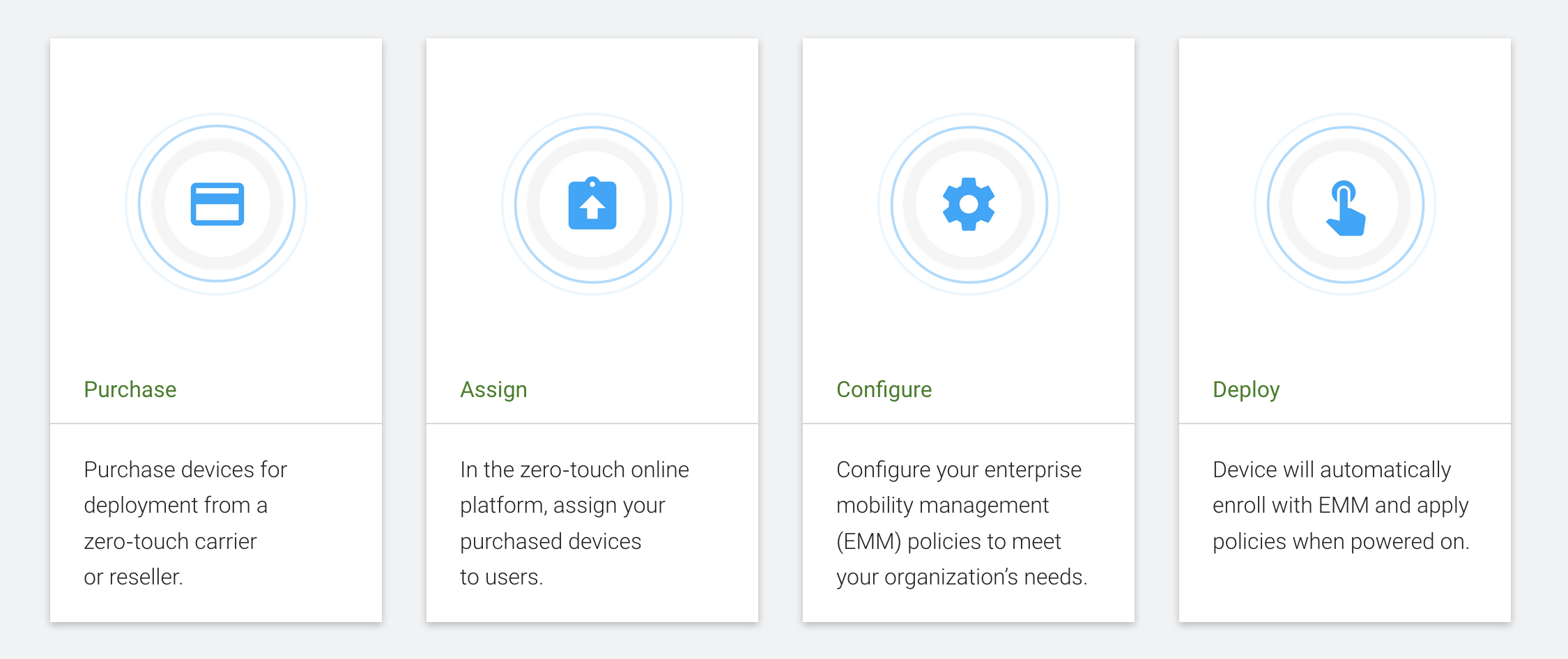
The simple zero-touch process
The zero-touch portal is designed with absolute simplicity in mind; much like the DEP portal (if you’ve ever used it) it’s basically there for you to infrequently log in, create or assign a config to managed devices and carry on with all other management via your normal EMM solution.
Creating configurations
#Once logged in, head over to Configurations to set one (or more) up, ready to assign to your devices:
Click the + icon on the right-hand side of Configurations to create a new configuration. This will open a pop-up.
To start, simply provide a configuration name, and then from the dropdown, a DPC (AKA EMM agent).
Following that is DPC extras, within this field you can paste in DPC-specific key-value pairs that add additional functionality. The key-value pairs differ by EMM, so it’s best to validate before pasting anything here. Leaving it blank is also fine. An example of what could go there for MobileIron Ivanti is as follows and more examples can be found on the zero-touch FAQ:
{
"android.app.extra.PROVISIONING_LEAVE_ALL_SYSTEM_APPS_ENABLED":false,
"android.app.extra.PROVISIONING_ADMIN_EXTRAS_BUNDLE":{
"server":"core.bayton.org",
"user":"zerotouchuser",
"quickStart":false
}
}
After which provide your company name, contact email, contact phone and an optional custom message. These will be presented to the end user while enrolling; particularly for support, having the contact name and telephone number of, perhaps, the IT Helpdesk could be quite useful.
When complete, click APPLY/Add to save the configuration and close out the pop-up.
Setting a default configuration
#Once you’ve created one or more configurations, you may wish for all devices added by a reseller to be given a configuration by default, thus avoiding having to sign in to the console every time a new device order is made. Above the list of configurations is a Default Configuration setting:
Previous console UI
Simply click the arrow to the right of Select a configuration and choose one from the dropdown list.
Applying configurations manually
#Click on Devices on the left-hand side. Once loaded you’ll be presented with a search area and a list of registered devices. Devices can be searched for based on IMEI, MEID or Serial number, or simply located by scrolling down the list.
New console UI
Once located, click Edit to the right of No config (or a presently-selected configuration) to open a dropdown, wherein you may select your newly created configuration(s).
Previous console UI
Once located, click the arrow to the right of No config (or a presently-selected configuration) to open a dropdown, wherein you may select your newly created configuration(s).
Confirm this selection when prompted. The device will now automatically enrol into the EMM of your choice when either first taken out of the box or on the next factory reset.
Deleting configurations
#New console UI
Should a configuration no longer be required, head back into Configurations and click Delete to the right of the configuration you wish to remove:
Confirm the action, and it'll vanish.
Previous console UI
Should a configuration no longer be required, head back into Configurations and click EDIT to the right of the configuration you wish to delete:
Click DELETE CONFIG. There is no confirmation so ensure you’ve selected the correct one before continuing!
Be aware if the config is used for devices or as the Default configuration this will be removed, and revert to none. You will be required to assign new configs to the respective default or individual devices to restore ZT functionality to new/existing devices.
Removing devices
#Should a device no longer require management, be that due to it being a parting gift for a leaving employee, device destruction or anything else, use the search area or scroll down the device list to locate the device on the Devices page. Once located, click UNREGISTER/Remove.
You’ll need to confirm this action, and please be aware this is not easily reversible! Once unregistered, you’ll need to contact your reseller to re-add the device back into your console manually; not an action to be taken on a whim.
Adding admins/owners
#The zero-touch console offers the ability to add additional "users" for easier management. There are two roles available when adding a new user, Owner and Admin. The only real difference between the roles is admins cannot add/delete other admins/owners, these roles can be changed at any time.
New console UI
To get started, head over to Users and click Add user
Input the Email Address, Role and click Add.
This will send out an invitation to the named account, allowing them to log in and perform their role-specific actions.
Only Google accounts are supported here, so ensure the email address added either belongs to Google Workspace, Cloud Identity, or is a Google account used for work purposes.
Previous console UI
To get started, click on Manage People:
Click the + icon on the right-hand side of the organisation name to add a new admin. This will trigger a popup.
Input the Email Address, Role and click APPLY.
Removing admins
#New console UI
To delete an admin, head back into Users and click Remove to the right of the admin you wish to delete:
Previous console UI
To delete an admin, head back into Manage People and click EDIT to the right of the admin you wish to delete:
Click DELETE. There is no confirmation so ensure you’ve selected the correct admin before continuing!
Adding resellers
#Occasionally you may wish to change resellers when purchasing zero-touch compatible devices. While it’s perfectly acceptable to request the new reseller sets you up with an account, the more convenient option for managing all devices from within one console is to simply add the new reseller to the existing customer account. To do so, head over to Resellers.
New console UI
Active resellers will be shown in the default (left) tab, with all other resellers available via Other resellers. There's even a handy count to let you know how many you have to choose from.
Scroll through the list of Other Resellers to locate the one you wish to add, then click Enroll.
Click Enroll/CONFIRM on the pop-up.
In the background, this sends a request to the reseller to accept your customer account. The reseller must accept your account in order to add devices into your console! Resellers cannot add themselves to your account without you opting to enrol, and once enrolled the new reseller cannot see the existing devices on your console, only those they add themselves.
Removing resellers
#To remove a reseller, preferably (but not necessarily) after all existing devices are unregistered and the relationship with the reseller terminated, head over to Resellers.
Scroll through the list of Active Resellers to locate the one you wish to remove, then click Remove/DELETE.
Click Remove/CONFIRM on the pop-up.
This will prevent the now-removed reseller from adding (or re-adding) devices to your console.
Docs
General
- Introduction
- What is Android Enterprise?
- Android versions matrix
- Considerations when migrating from device administrator to Android Enterprise
- Android Enterprise feature requests
- What is Android Enterprise Recommended?
- Android Enterprise FAQ
- Android Enterprise device testing
- What is Private Space in Android 15, and how can organisations manage it?
- Why don't all Android devices come with GMS?
- What is Android One?
- Android Enterprise vs Device Admin: Why DA is no longer suitable
- Considerations for choosing Android in the Enterprise
- Feature spotlight: Android Smartlock
- Android glossary
- Android version evolution graphics
- Infobyte: Device Admin deprecation
- How to submit a device for Android Enterprise Recommended validation
- How to capture a bug report and device logs
- How to view software version information
- Gartner comparison of security controls for mobile devices 2019
Provisioning
- How to become a zero-touch enrolment reseller
- What is Android zero-touch enrolment?
- Android Enterprise zero-touch console administration guide
- Android Enterprise DPC identifier collection
- Android Enterprise provisioning guides
- Android Enterprise zero-touch DPC extras collection
- Infobyte: Android Enterprise deployment scenarios
- Infobyte: Android Enterprise fully managed provisioning methods
- Manual Android Enterprise work-managed QR code generation for MobileIron
Work profile
Fully managed
App management
- Set up Hypergate's Kerberos Authentication on MobileIron Core for Android Enterprise
- Managed Google Play, allowlist or blocklist?
- Considerations when deploying MTD with Android Enterprise
- Why you shouldn't install apps from unknown sources
- Create and manage private apps for Android Enterprise
- What is OEMConfig?
- Create and manage web apps for Android Enterprise
- How to locate a private Android app assigned to an organisation ID
- How to host enterprise apps outside of Google Play
- The Google Play iFrame app approval flow is deprecated
- Android 13 adds notifications access as a runtime permission
- Android 14 blocks apps targeting old Android versions
- Android 13 & up restricts permissions when apps are sideloaded
- Android system apps database
- How to resolve common Android app install failures, by error message
FAQ
- Is Android Enterprise supported on uncertified (non-GMS) devices?
- Can apps be sideloaded into the Private Space?
- Is Private Space supported on fully managed devices?
- Why don't Private Space apps go through VPN?
- Is it possible to manage personal applications on a work profile device?
- Does Samsung support Android Enterprise?
- How can apps be managed in the Private Space?
- Are Private Space apps visible to enterprise admins?
- Are Private Space applications truly hidden?
- Why has USB data access been disabled suddenly?
- What versions of Android support Android Enterprise?
- Is it possible to manage eSIM?
- How to check if an Android device is GMS/Play Protect certified?
- To use Android Enterprise do I need to buy Google Workspace (G Suite) and register my domain?
- What devices should I buy for my organisation?
- If Android Enterprise is supported from Lollipop, why is Marshmallow often mentioned instead?
- What’s the difference between Device Admin and Android Enterprise?
- What is the Android Enterprise bind?
- Can I change the account I used to bind Android Enterprise?
- Is it possible to bind Android Enterprise with multiple EMMs using one account?
- How do I remove the Android Enterprise bind from my current EMM?
- What is Android Enterprise Recommended?
- My AER device doesn’t work properly with Android Enterprise, what should I do?
- Is Android One better than AER? (Or the other way around?)
- How do I configure Google Workspace domains for provisioning?
- What’s the best provisioning method?
- What’s the difference between allow adding accounts vs allow configure credentials?
- Is it possible to utilise multiple VPN connections within a profile?
- Is it possible to utilise a single VPN connection across the entire device?
- Does Android support Kerberos natively?
- What’s the difference between device based accounts and user based accounts?
- How do I manage the new notifications runtime permission in Android 13?
- Can organisations see applications outside of the work profile?
- Can organisations deploy applications to the parent profile in a work profile deployment?
- Is it possible to migrate from DA to AE work profile without a re-enrol?
- What is a work challenge?
- Enrolment failed but the work profile was created. How do I remove it?
- How can I provision a fully managed device?
- Is it possible to “retire” (or enterprise wipe) a fully managed device?
- Devices factory reset as soon as they’re enrolled, why?
- Is Factory Reset Protection enabled on fully managed devices?
- Is it possible to migrate fully managed devices between EMM solutions?
- How has COPE changed in Android 11?
- Does Intune support COPE?
- Can organisations see applications outside of the work profile on a COPE device?
- Can organisations deploy applications to the parent profile in a COPE deployment?
- Is it possible to migrate from fully managed to work profiles on fully managed devices?
- How should system applications be handled on a COPE device?
- What OEMs currently support zero-touch?
- Where are zero-touch resellers located?
- Does zero-touch cost anything?
- Is an EMM still required with zero-touch?
- What happens if a fully set up device is added to the zero-touch console?
- What happens if a user starts setting up a device before the zero-touch config is applied?
- What happens if a zero-touch config is removed from an enrolled device?
- What happens if a new config for a different EMM or server is applied to an enrolled device?
- Can I add/remove users on a fully managed device?
- How can I access a Wi-Fi captive portal when devices are in Kiosk?
- What happens if a zero-touch assigned device is reset?
- What happens if a device is unregistered from the zero-touch console?
- Can a device be OTA managed from the zero-touch console?
- Does enrolling via zero-touch slow down or cause any delay to the setup process while it’s retrieving the zero-touch config?
- What deployment scenario will a zero-touch device enrol under?
- Why does zero-touch require so much touching?
- Can anyone add a device to the zero-touch console?
- Is it possible for an organisation to add previously-purchased devices to zero-touch?
- Can a MADA device be converted to EDLA?
- Can anyone remove a device from the zero-touch console?
- Does Samsung support zero-touch?
- Is it possible to set a zero-touch default configuration?
- Is it possible to bulk update zero-touch devices?
- Is it possible to change zero-touch resellers?
- Are all zero-touch devices Android Enterprise Recommended?
- What are DPC extras?
- What should I put in DPC extras?
- What happens if a device is uploaded to zero-touch with the wrong manufacturer?
- The device registered with zero-touch, but doesn’t launch during setup, why?
- Does Android Go support zero-touch?
- Are employee-owned devices eligible for zero-touch?
- What’s the recommended way of managing private (in-house) applications?
- How do I turn off Google Play app collections?
- Is it possible to deploy app shortcuts to the homescreen of an Android Enterprise device?
- Is it possible to backup & restore device data on a fully managed device?
- The Google Play iFrame is missing a feature in my UEM. How do I enable it?
- How do I configure allowlist/blocklist domains for Google Chrome?
- How to configure Chrome managed bookmarks
